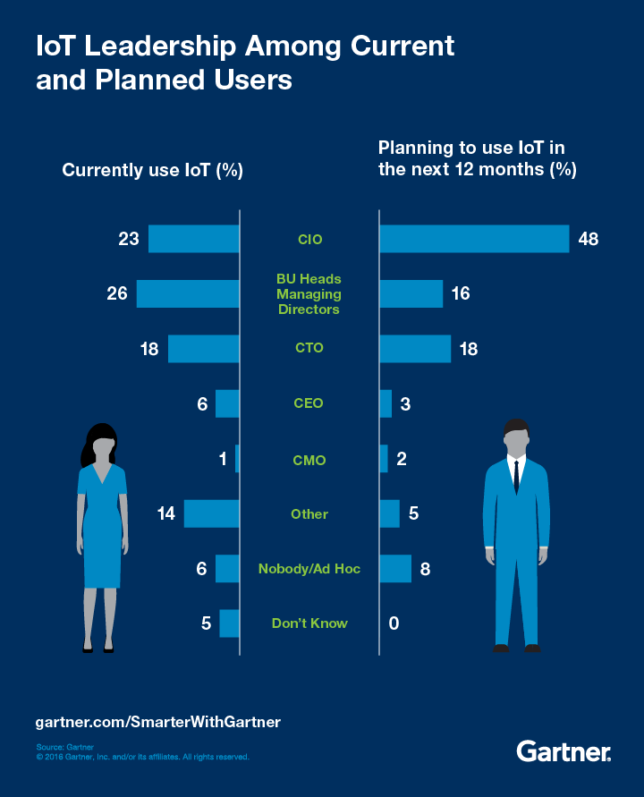The Internet of Things (IoT) is a magnificent opportunity for growth and profit, but until now it has largely labored behind the scenes to improve efficiencies.
According to Chet Geschickter, “IoT is moving toward mainstream adoption in 2016 and the number of organizations adopting IoT will grow 50% in 2016 reaching 43% of organizations overall”.
Below you can see a Gartner chart showing -Organization’s IoT Leadership- among current and planned users in the next 12 months.

Based on this information, Chief Information Officers (CIOs) will lead the charge as more companies deploy Internet of Thigs for customers. CIOs will play a key role in the IoT business transformation forcing them to become more business savvy and keep a good balance between information technology (IT) and operational technology (OT).
IoT initiatives are shifting focus from internal benefits, -operations-, to external benefits, -customers-.

The main roadblocks IoT is facing are:
- Lack of Leadership
- Unclear Business Benefits
- Lack of Internal Expertise
- Lack of External Expertise
This is because senior levels (executives, board of directors) of organizations and non-IT workers don’t yet have a good understanding of the potential impact of the IoT. The real challenge of the Internet of Things for senior levels is to understand the business opportunities enabled by smart products and new ecosystems.
In order to succeed when establishing an IoT initiative, businesses need to be in constant communication with IT to better understand the challenges and what resources IT will need to get it off the ground. IoT initiatives are big undertakings that need a strong IT and other business areas partnership and solid external partnerships with third party companies to supplement internal resources. Everyone needs to be on the same page and working together to move the whole enterprise through the changes an IoT initiative will demand.
Companies agree that IoT initiatives will have a long-term impact on the business. Senior levels are aware of a growing impact from the IoT, but still haven’t figured out how to successfully implement it into the overall business plan.
Some of the companies’ IoT objectives in the next five years are:
- Help Improve User and Customer Experiences
- Innovation
- Business Process Efficiencies
- New Revenue Stream
- Increase ROI of IoT Projects
- Operational Efficiencies and Cut Cost

This means business needs to get started on Internet of Things initiatives as soon as possible, so that they can grow and evolve effectively. IoT can greatly benefit the enterprise even though business leaders will face roadblocks and challenges when considering IoT adoption.

Pingback: IoT Big Data - Predictive Analytics and SAP Solution • The Internet of Things